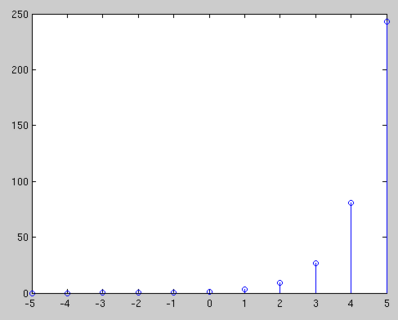| Line 81: | Line 81: | ||
---- | ---- | ||
[[2013_Fall_ECE_438_Boutin|Back to ECE438 Fall 2013 Prof. Boutin]] | [[2013_Fall_ECE_438_Boutin|Back to ECE438 Fall 2013 Prof. Boutin]] | ||
| + | |||
| + | |||
| + | ===Answer 5=== | ||
| + | |||
| + | Yixiang Liu | ||
| + | |||
| + | x[n] = 3^{n}u[n+3] | ||
Revision as of 16:13, 12 September 2013
Contents
Practice Problem on Z-transform computation
Compute the compute the z-transform (including the ROC) of the following DT signal:
$ x[n]=3^n u[n+3] \ $
(Write enough intermediate steps to fully justify your answer.)
You will receive feedback from your instructor and TA directly on this page. Other students are welcome to comment/discuss/point out mistakes/ask questions too! No need to write your name: we can find out who wrote what by checking the history of the page.
Answer 1
alec green
$ X(z) = \sum_{n=-\infty}^{+\infty} x[n]z^{-n} $
$ = \sum_{n=-3}^{+\infty} 3^{n}z^{-n} $
$ = \sum_{n=-3}^{+\infty} (\frac{3}{z})^{n} $
Let k = n+3:
$ = \sum_{k=0}^{+\infty} (\frac{3}{z})^{k-3} $
Using the geometric series property:
$ X(z) = \left\{ \begin{array}{l l} (\frac{z}{3})^3 \frac{1}{1-\frac{3}{z}} & \quad |z| > 3\\ \text{diverges} & \quad \text{else} \end{array} \right. $
Answer 2
Muhammad Syafeeq Safaruddin
$ x[n] = 3^n u[n+3] $
$ X(z) = \sum_{n=-\infty}^{+\infty} x[n] z^{-n} $
$ X(z) = \sum_{n=-\infty}^{+\infty} 3^n u[n+3] z^{-n} $
$ X(z) = \sum_{n=-3}^{+\infty} 3^n z^{-n} $
$ X(z) = \sum_{n=-3}^{+\infty} (\frac{3}{z})^{n} $
Let k = n+3, n = k-3
$ X(z) = \sum_{k=0}^{+\infty} (\frac{3}{z})^{k-3} $
$ X(z) = (\frac{z}{3})^{3} \sum_{k=0}^{+\infty} (\frac{3}{z})^{k} $
$ X(z) = (\frac{z^3}{27}) \sum_{k=0}^{+\infty} (\frac{3}{z})^{k} $
$ X(z) = (\frac{z^3}{27}) \sum_{k=0}^{+\infty} (\frac{3}{z})^{k} $
By geometric series formula,
$ X(z) = (\frac{z^3}{27}) (\frac{1}{1-(\frac{3}{z})}) $ ,for |z| < 3
X(z) = diverges, else
So,
$ X(z) = (\frac{z}{z-3}) $ with ROC, |z| < 3
Answer 3
Write it here.
Answer 4
Write it here.
Back to ECE438 Fall 2013 Prof. Boutin
Answer 5
Yixiang Liu
x[n] = 3^{n}u[n+3]


